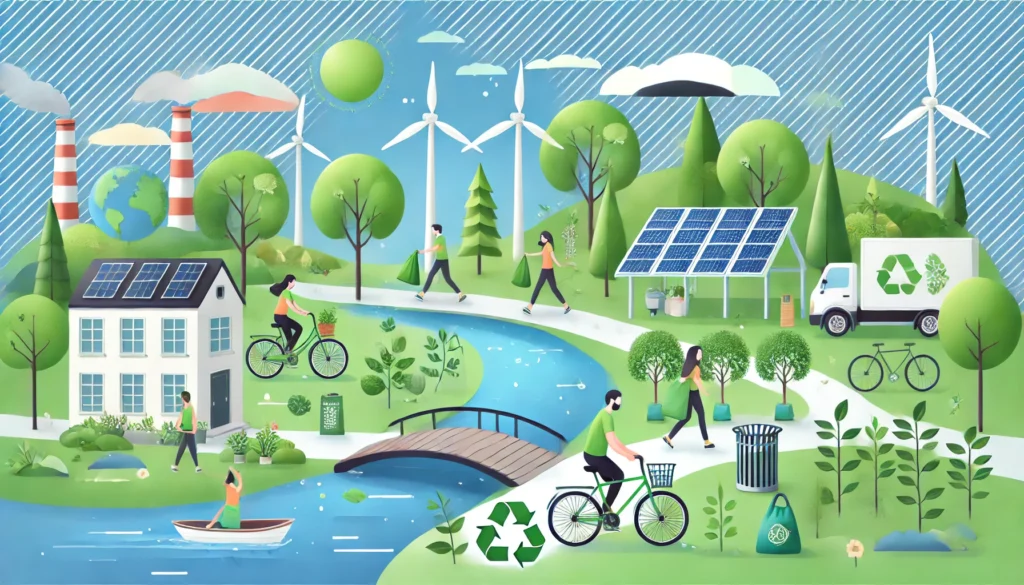“Eat Local, Think Global” is a simple yet powerful philosophy that encourages individuals to consume food produced locally while considering its global impact. By focusing on local produce, we can help reduce our carbon footprint, support local farmers, and contribute to the health of our planet. This article explores why eating local is crucial, how it affects global sustainability, and the numerous benefits it provides both environmentally and economically.
What Does “Eat Local, Think Global” Mean? 🌱
The phrase “Eat Local, Think Global” promotes the idea that we can contribute to global sustainability by making conscious food choices at the local level. It means purchasing and consuming food that is grown and produced locally rather than relying on imports. This practice reduces the environmental impact associated with food transportation, packaging, and storage. By thinking globally, we consider the larger environmental consequences of our consumption patterns, such as the carbon emissions associated with food production and transport.
Why Should We Eat Local? 🥦
Eating local has several benefits for the environment, economy, and personal health:
- Environmental Impact: Local food reduces the need for long-distance transportation, which lowers carbon emissions. This practice helps combat climate change and reduces pollution.
- Support for Local Farmers: Buying from local producers boosts the rural economy and helps sustain small-scale farmers. This keeps local communities economically vibrant and ensures the availability of fresh food.
- Fresher and Healthier Food: Local produce is often fresher as it does not require long storage times. Fresher food means better nutrition and fewer preservatives or chemicals used to extend shelf life.
How Can You Eat Local? 🍽️
Eating local doesn’t have to be complicated. Here are some practical steps you can take to adopt this lifestyle:
- Shop at Farmers’ Markets: These are great places to find fresh, local produce and other food items like dairy, eggs, and honey.
- Join a Community-Supported Agriculture (CSA) Program: CSA programs allow you to purchase shares of produce directly from a local farm, ensuring fresh seasonal produce on a regular basis.
- Grow Your Own Food: If you have the space, consider starting a small garden. Even growing herbs or vegetables in containers can contribute to your local eating habits.
- Choose Seasonal Foods: Eating foods that are in season in your region reduces the demand for imported produce, supporting local agriculture.
Where Can You Find Local Food? 🌾
- Farmers’ Markets: These are excellent sources for local, fresh produce, dairy, and meats. Farmers’ markets are often available weekly in most cities and towns.
- Local Grocery Stores: Some supermarkets offer locally sourced products, often labeled as such, so you can easily spot them.
- Local Farms: Many farms offer direct-to-consumer sales or farm-to-table delivery services that provide fresh produce right to your doorstep.
When Should You Prioritize Local Eating? 🕑
The best times to eat locally are during the growing season in your area when local fruits and vegetables are in abundance. It’s also helpful to consider local food year-round by preserving seasonal foods through methods like canning, freezing, or dehydrating.
How Much Does Eating Local Cost? 💰
The cost of eating local food can vary based on where you live. In some cases, local produce can be more affordable than imported options, especially during the peak harvest season. However, local organic products may be slightly more expensive than conventionally grown food. The cost benefits come in the long term, as local food supports the local economy and reduces the environmental costs associated with long-distance transportation.
Advantages of Eating Local 🌟
- Lower Carbon Footprint: Reducing the transportation distance of food decreases carbon emissions and contributes to combating climate change.
- Support for Local Economies: Money spent on local food stays within the community, supporting local farmers and creating jobs.
- Better Nutrition: Local foods are often fresher, which means they retain more nutrients compared to foods that have been transported long distances.
- Preservation of Biodiversity: Local farms are more likely to grow a variety of crops, supporting biodiversity and reducing the environmental impact of monoculture farming.
Disadvantages of Eating Local ⚖️
- Limited Variety: Depending on your location, certain foods may not be available year-round, which can limit variety.
- Higher Costs for Some Products: Organic or sustainably farmed local foods may be more expensive than mass-produced alternatives.
- Seasonal Restrictions: If you live in regions with harsh winters or dry seasons, it can be difficult to find fresh local produce year-round.
Cost Benefits of Eating Local 💵
While local food may sometimes cost more upfront, it offers numerous long-term cost benefits:
- Reduced Transportation Costs: Less distance means lower transport costs and fewer resources used in storage and packaging.
- Health Savings: Eating fresher, more nutritious food can lead to better overall health, reducing medical expenses.
- Sustainable Economy: Supporting local businesses helps keep money within your community, boosting local economic growth and reducing reliance on imported goods.
Think Global, Act Local 🌏
The concept of “Eat Local, Think Global” is more than a trend—it’s a movement that empowers individuals to make more sustainable food choices that have far-reaching global impacts. By supporting local food systems, we can create a more resilient and sustainable world, protect the environment, and support local economies.
Discover more from Green Ecosystem - Renewable Energy, Agriculture, and Environmental Sustainability
Subscribe to get the latest posts sent to your email.


